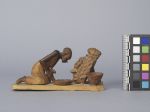Thorn Carving
About this object
History of use
Thorn carvings are miniatures depicting a variety of scenes from Nigerian life. The carvings first began to be made circa 1930. The thorns vary in size; they can be as large as 12.7 cm long and 9.6 cm wide. The thorn wood is comparatively soft and easy to carve; they are traditionally carved by men.
Narrative
Most of the Nigerian objects in the Lieber collection were assumed to have been collected while Jack Lieber was living in Nigeria, 1965-1970. However one of the thorn carvings was made after 1971, so the dates are uncertain.
Cultural context
craft; tourist art
Specific techniques
The light yellow-brown thorn and the dark brown thorn come from the ata tree; the light red-brown thorn comes from egun trees. The parts are glued together with viscous paste made that was made from rice cooked with water.
Categories

Date Made
C. 1970 ?
Date Acquired
18 Jun 2018
How Acquired
Donated
Credit Line
Measurements
Overall: 6.3 cm x 13.5 cm x 6 cm
Object Number
3326/34